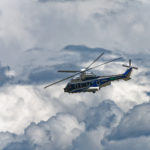Caption: As the last four iconic 747s sit on the assembly line, this is number two – set to be delivered to Atlas (which will receive three freighters) by the end of summer.
It’s the end of an era for the 747 as the last four freighter aircraft are on the assembly line at Boeing’s Everett facility, reports Marcelle Nethersole in Seattle.
“The 747 has had a remarkable run since 1969, but sadly, production concludes this year,” said Brian Hermesmeyer, freighter customer leader.
The 747 came to fruition in 1965 after the head of Pan Am, Juan Trippe, noted that as people started to travel by air more, airports became congested.
Super-sized aircraft
Trippe asked Boeing to take on the challenge to manufacture a super-sized aircraft, twice the size of the Boeing 707, to cope with the demand.
Boeing engineer, Joe Sutter was brought in by Boeing’s then president, Bill Allen, to work on the ‘jumbo jet’. Just 18 months later Sutter – who became known as ‘the father of the 747’, and his team completed the iconic aircraft.
However, one hurdle that had to be overcome was that the aircraft was so large – 231ft nose to tail and a wingspan of 195ft – that Boeing simply didn’t have the space to build it. So, a new assembly plant was rolled out.
Impressive scale
Today, the Everett building is still the largest enclosed space in the world. A single hangar door is the size of a football pitch.
For the four 747-8 dash aircraft on the line, the story is not over.
“Yes, production is concluding, but the aeroplanes that we’ve delivered to the market are going to continue to fly for many years – as are these on the production line,” said Hermesmeyer. “They’re going to continue to serve the customers for many years. We obviously are committed to making sure that the aircraft lives out its
lifecycle the way it’s supposed to.”
Significant capabilities
Hermesmeyer added the 747s do have some really significant capabilities. “There is no other nose loader out there – nor is there one on the horizon right now,” he said.
“While we are now looking at our next generation freighter, the 777-8, we will continue to study the market to make sure that when the time is right, we have the right solution in the right space for customers.”
During the pandemic, over 431,000 revenue flights were flown and over 34 million tonnes of cargo carried.
Industry workhorse
“The industry really does rely on this aeroplane and they’re going to be able to continue to rely on it for years to come,” said Hermesmeyer.
And the huge team working on the 747 programme also feel the end of the era. “Thousands of people have worked on the programme since it started, and those staff feel a sense of pride,” said Hermesmeyer.
“For current staff on it, many will retire, while the others will be transferred to other programmes.”
Final 747s
The final 747s currently on the assembly line are all due for completion and delivery by the end of the year.
When the last 747 reaches the end of the line, it will bow out as number 1574.
Subscribe to the FINN weekly newsletter

